Fever in Children
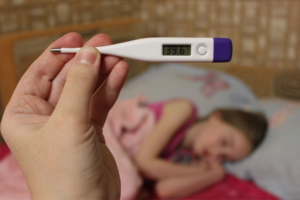
Sometimes children develop fevers. Here are some things for you to know.
The most common cause of fever in children is infection. For example, children can get a fever if they have:
- A cold, flu or covid.
- An airway infection, such as croup or bronchiolitis.
- A stomach bug.
- In some cases, children get a fever after getting a vaccine.
What is a fever?
Fever is a rise above the average body temperature. In general, 38°C (100.4ºF) is considered a fever. A fever is a symptom, not a disease, usually caused by an infection or a normal vaccine reaction.
Not all fevers are dangerous. A child with a mild infection can have a high temperature, while a child with a severe infection might have no fever. Higher temperatures do not mean an illness is more serious; how your child looks and acts is a more important measure of an illness.
Types of thermometers to use:
You might get slightly different numbers than those above depending on where you take your child’s temperature – mouth, armpit, ear, or bum.
Digital thermometers are the most accurate and can be used in the bum (rectally), in the mouth under the tongue (orally), or in the armpit (axillary).
If you find using a thermometer in the bum or mouth to be difficult… (click to expand) »If you find using a thermometer in the bum or mouth to be difficult, ask your healthcare provider if you may use:
|
Plastic strip thermometers, pacifier thermometers, glass thermometers, or smartphone temperature apps are not reliable methods to take a child’s temperature.
How do I take my child’s temperature?
Here are some tips to remember for any method you use:
- Avoid taking your child’s temperature right after a bath as this can affect the reading.
- Stay with your child while taking a temperature.
- mercury glass thermometers are dangerous for your child if they break.
- Be sure to read the package instructions for your thermometer.
- Follow the cleaning instructions on the package before and after use.
How to take a temperature in the bum (birth to four years) (click to expand) »
|
How to take a temperature in the armpit (all ages) (click to expand) »
The armpit is not as accurate as a rectal temperature. If this method does not show a fever, but your child feels warm and unwell, take a rectal measurement.
|
How to take a temperature in the ear (three years and up) (click to expand) »
The ear method is quick but can give temperature readings that are too low, even when following the manufacturer’s directions.
|
How to take a temperature by mouth (five years and up) (click to expand) »
|
What is a normal temperature?
| Method | Normal temperature range | Fever |
| Rectum | 36.6°C to 38°C
(97.9°F to 100.4°F) |
38°C or higher
(100.3°F or higher) |
| Armpit | 36.5°C to 37.5°C
(97.8°F to 99.5°F) |
37.6°C or higher
(99.6°F or higher) |
| Ear | 35.8°C to 38°C
(96.4°F to 100.4°F) |
38°C or higher
(100.5°F or higher) |
| Mouth | 36°C to 37.5°C
(97.2°F to 98.6°F) |
37.6°C or higher
(99.6°F or higher) |
What do I do if my child has a high temperature (fever)?
Call your healthcare provider immediately if your child:
- is under three months of age.
- appears to be and acts very ill; or
- has a rash, cough, or wheeze with the fever.
Call your healthcare provider within 24 hours if your child is:
- between three and six months of age.
Call your healthcare provider if:
- the fever has lasted over 24 hours with no obvious cause.
- the fever lasts more than three days.
- the fever returns within 24 hours of relief; or
- you are concerned.
What can I do to help my child feel better?
Click here for some tips (click to expand) »
|
Services related to this information:
- Contact your Public Health Nurse:
- 811 HealthLine (Newfoundland & Labrador) – Call 811 or 1-888-709-2929 / TTY 1-888-709-3555.
- Your Physician/Nurse Practitioner
- Pharmacist
- Local health clinic

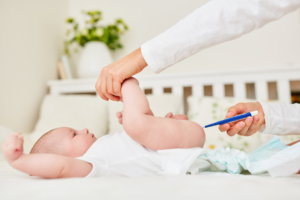 Always label a thermometer used in the bum clearly, and never use it in the mouth.
Always label a thermometer used in the bum clearly, and never use it in the mouth.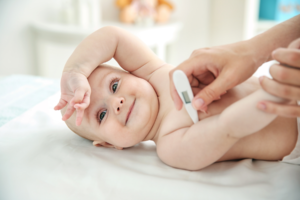
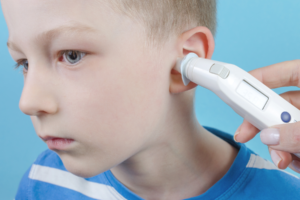
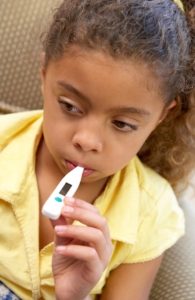 Taking an oral temperature is easier in an older, cooperative child.
Taking an oral temperature is easier in an older, cooperative child.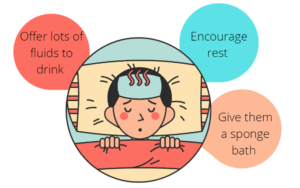 Offer lots of fluids to drink. Call 811 if your child does not drink fluids for more than a few hours.
Offer lots of fluids to drink. Call 811 if your child does not drink fluids for more than a few hours.